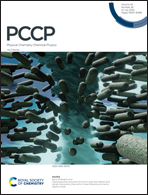Electrochemical CO2 reduction on Cu single atom catalyst and Cu nanoclusters: an ab initio approach†
Abstract
The electrochemical CO2 reduction presents a sustainable route to the production of chemicals such as ethylene or ethanol, however the design of selective catalysts is still challenging. The use of single site copper nitrogen doped carbon materials with porphyrin-like Cu graphene structures have shown a significant improvement towards the production of multi carbon products, particularly ethanol. Nonetheless, during reaction the porphyrin like Cu sites transiently convert into metallic copper nanoclusters in a reversible process, making difficult to understand the actual role of each phase. Here, we present a computational study, where adequate structural models to describe the experimentally determined phases of the single atom catalyst (Cu–N–C material) have been constructed. Moreover, the electrochemical reduction of CO2 to ethanol and ethylene has been addressed via periodic DFT calculations on each of the systems. On the basis of the computed free energies of reaction, it was found that the Cu nanoclusters exhibit a superior performance for the CO reduction in comparison with the single site. Moreover, they possess a high activity towards the production of ethanol, suggesting them as the active phase responsible for the catalytic performance of the studied material.



 Please wait while we load your content...
Please wait while we load your content...